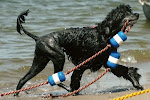I'll be honest, I haven't read them all!! There are many dealing with entries, aggressive dogs, and over various topics that I wouldn't probably ever need. That being said, if you have a dog that, barks at the judge, will run toward a dog at the start line, or any other type of behavior that could be seen as 'aggressive', I'd suggest you read that part of the rule changes.
On to Equipment!! It wasn't clear to me when some of these changes go into effect. I've heard that the table is as of 9/1/10, but not sure about the others.
First off, weave poles! I don't know about you, but I thought they were going to "Require" 24" poles as of 7/1/10, that is NOT the case! (Not until January 1, 2012) So, you might want to stay practiced in those 20"-22" poles!
A-Frame Height - The height of the A-Frame is to be set within 1 inch of 5 feet 6 inches, except for 4-inch and 8-inch jump heights, which shall have the A-Frame set to within 1 inch of 5 feet 0 inches. (I'm not sure when this changes?) I know in USDAA it's rather a hassle and there are times it's not changed, although their height isn't this low. If you're the first dog up in a class that (has or had) a varied A-Frame height, please be sure you're looking!
Dog Walk - It appears that the up contact on the dog walk will not be judged. I'm sure this is due to so many running dog walks now a days! It's almost impossible to be at both ends. This does NOT apply to the Teeter however, so you must hit the up side there.
Table (I can hear some of you cheering NOW!!!)
The dog shall pause on the table for five cumulative seconds. The judge’s count shall
start once all four (4) paws have touched the table (and the dog remains on the table top). Neither a sit or a down position shall be required.
Tire Jump’s height shall be set one jump height lower than the Bar Jump height, with the exception of the 4-inch jumping dog.
I'
Tire Jump Height vs. Bar Jump Height
4 Inches 4 Inches
4 Inches 8 Inches
8 Inches 12 Inches
12 Inches 16 Inches
16 Inches 20 Inches
20 Inches 24 Inches
24 Inches 26 Inches
Standard Course Times - The 8" and 24" divisions will see a slight increase in SCTs.
o 8-inch Division: 1.85 yards per second, plus 5 seconds for the Pause Table
o 12-inch Division: 2.0 yards per second, plus 5 seconds for the Pause Table
o 16-inch Division: 2.15 yards per second, plus 5 seconds for the Pause Table
o 20-inch Division: 2.25 yards per second, plus 5 seconds for the Pause Table
o 24-inch Division: 2.20 yards per second, plus 5 seconds for the Pause Table
o 26-inch Divisions: 2.25 yards per second, plus 5 seconds for the Pause Table
Placements for 1st and 2nd place will no longer have multipliers as of 7/1/11. That makes perfect sense to me, as those dogs more than likely don't need the points. It might have been fun to give multipliers to the bottom two dogs in the class? Those are probably the ones that need them!
There as also new titles being added in the future, life time achievement titles, etc. That's something you'll want to follow up on if you're interested. There are 61 pages of material to sort through. I think I've hit most of the highlights!
How to Help a Stressed Dog During the Holidays
2 weeks ago


















